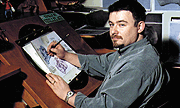|
|
ANIMATION WORLD MAGAZINE - ISSUE 5.03 - JUNE 2000
|
Disney Takes a BIG Departure from Formula with Dinosaur
Drawing From Life
After animation was completed, intricate skins were painted on using a technique that matched points on the skin to the muscles underneath, creating a believable effect. Hundreds of shaders were written to create the unique look of surfaces, lighting and shadows. Additional effects such as dust and splashing water were filmed in live-action then applied to the characters. Integrating the CG and live-action elements proved to be quite a challenge. Mammoth Technology At the conclusion of production on Dinosaur, the digital studio joined with Disney’s effects division Dream Quest to form a new entity called the Secret Lab, now co-located in a modern building near the Burbank airport. The name accurately portrays Disney’s closed-door policy about projects in development. Even family members are not allowed in the studio. Mike Belzer and other animators are currently working on several new CG films at Disney, which are of course under wraps. Wendy Jackson Hall is an independent animator, educator, writer and consultant specializing in animation. Her articles have been published in Animation Journal, Animation Magazine, ASIFA News, the Hollywood Reporter, Variety and Wired. She was previously associate editor of Animation World Magazine. |
Note: Readers may contact any Animation World Magazine contributor by sending an e-mail to editor@awn.com.


